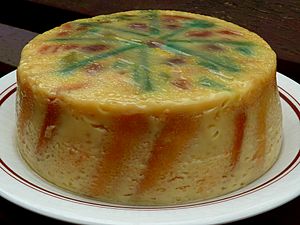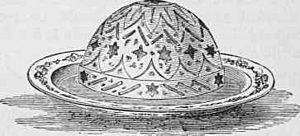Cabinet pudding facts for kids

Cabinet pudding (from a 1963 recipe)
|
|
| Alternative names | Chancellor’s pudding Newcastle pudding |
|---|---|
| Type | Pudding |
| Place of origin | United Kingdom |
| Main ingredients | Bread or sponge cake, dried fruits |
Cabinet pudding is a classic English dessert. It's a sweet, steamed pudding often called chancellor's pudding or Newcastle pudding. This tasty treat is made from bread or sponge cake mixed with custard. It's cooked in a special mould, often decorated with colorful fruits like cherries or raisins. People usually enjoy it with a sweet sauce. Sometimes, other versions of cabinet pudding are made with gelatin and whipped cream, making them light and fluffy.
How Was Cabinet Pudding First Made?
One of the very first recipes for cabinet pudding was written down in 1836. It appeared in a cookbook called The Art of Cookery by John Mollard. This old recipe tells us how to make the pudding using cream or milk, cinnamon, and lemon peel.
It also suggests using Savoy cake or sponge biscuits. After mixing everything, you would add chopped almonds and well-beaten egg whites. The pudding was then cooked in a mould placed in boiling water. When served, it came with a special sauce made from butter, flour, white wine, brandy, and lemon juice. Sounds delicious, right?
Cabinet Pudding in Books
This yummy pudding has even appeared in famous books!
- In 1826, a writer named Benjamin Disraeli mentioned it in his first novel, Vivian Grey. In the story, the main character teaches someone how to eat cabinet pudding with a special curacao sauce. Benjamin Disraeli later became a very important politician, serving as the Prime Minister of the United Kingdom!
- In the book London Belongs to Me, a character named Mr. Josser gets upset when his cabinet pudding is served with custard instead of the white sauce he prefers.
- Another mention is in John O'Hara's 1958 novel, From the Terrace. Here, the main character, Alfred Eaton, enjoys cabinet pudding for dessert after being offered a big job.
It seems cabinet pudding has been a favorite dessert for a long time, even for characters in stories!


